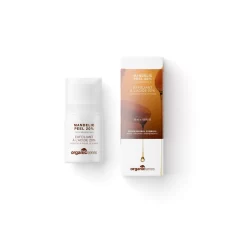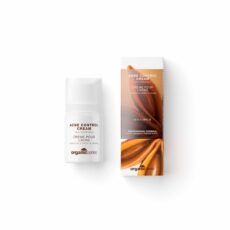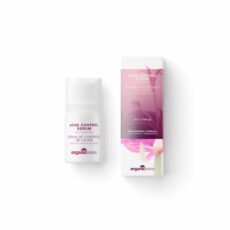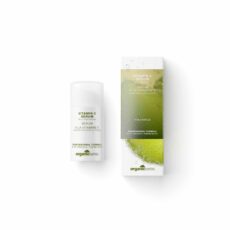Face Cream for Acne
Face cream for acne: Finding the perfect face cream for acne can be challenging, as the right product must address breakouts, balance oil production, and soothe irritated skin without causing dryness or further irritation. With so many skincare products on the market, it’s crucial to know what to look for when selecting the best face cream for acne-prone skin. Here are 12 essential steps to help you find the ideal acne-fighting face cream for your skin type.
1. Identify Your Skin Type
Before selecting the best face cream for acne, it’s essential to understand your specific skin type. Acne can affect different skin types in various ways, so a one-size-fits-all approach won’t work. For example, oily skin may produce excess sebum, clogging pores and leading to breakouts, but it can still become dehydrated without the right cream. On the other hand, combination skin may be oily in certain areas like the T-zone while being dry on the cheeks, making it tricky to find a balanced product.
If you have dry skin, you’ll need a face cream that hydrates while addressing acne without worsening dryness. Sensitive skin, meanwhile, requires careful attention to ingredients, as harsh chemicals or overly active ingredients can exacerbate irritation or inflammation. Understanding your skin type ensures that you pick a cream with the right balance of hydration, acne-fighting ingredients, and soothing agents to avoid further irritation or worsening of your skin condition.
2. Look for Non-Comedogenic Formulas
Choosing a non-comedogenic product is crucial when dealing with acne-prone skin. Non-comedogenic products are formulated specifically not to block pores, which can significantly reduce the risk of further breakouts. Many skincare products, even those marketed for acne, contain ingredients that can clog pores if you’re not careful. Ingredients like heavy oils, waxes, and certain silicones can trap bacteria and excess oil in your pores, leading to more blackheads, whiteheads, and inflammation.
When searching for a face cream, always check the label for “non-comedogenic.” This ensures that the product is safe for acne-prone skin and reduces the likelihood of developing additional skin issues. Beyond just controlling acne, non-comedogenic creams are often lightweight and easily absorbed, making them suitable for layering under makeup or sunscreen without feeling greasy.
3. Opt for Oil-Free Products
Face creams that are oil-free are particularly important for those with acne-prone skin, especially if you have oily or combination skin. Oil-based products, even those that contain “natural” oils, can add excess oil to the skin, exacerbating breakouts. When your skin is already producing too much oil, applying additional oils can overwhelm the skin, clog pores, and lead to further acne flare-ups. An oil-free face cream allows your skin to stay hydrated without contributing to the buildup of sebum in your pores.
Even if your skin feels dry in some areas, an oil-free moisturizer can still provide adequate hydration without leaving a greasy residue. Moreover, oil-free creams often contain lightweight, water-based hydrating agents like glycerin or hyaluronic acid, which keep the skin moisturized while balancing oil production and preventing acne.
4. Check for Acne-Fighting Ingredients
When choosing the best face cream for acne, look for products that contain proven acne-fighting ingredients. Ingredients like salicylic acid, benzoyl peroxide, and tea tree oil are well-known for their ability to target acne by reducing inflammation, killing acne-causing bacteria, and exfoliating the skin. Salicylic acid, a beta-hydroxy acid, helps unclog pores by exfoliating dead skin cells and reducing inflammation. Benzoyl peroxide, on the other hand, works by killing bacteria on the skin’s surface and preventing future breakouts. Tea tree oil is a natural antibacterial agent that can soothe irritated skin while keeping acne-causing bacteria at bay.
In addition to these, ingredients like niacinamide and sulfur can help regulate oil production and calm inflammation, making them suitable for treating acne. When choosing your cream, consider your skin’s tolerance to these active ingredients, as some, like benzoyl peroxide, can be drying, while others may be gentler yet effective over time.
5. Moisturize Without Over-Drying
One of the biggest misconceptions about acne-prone skin is that it doesn’t need moisturizing. In fact, skipping moisturizer can lead to even more oil production as your skin tries to compensate for the lack of hydration. The key is to find a cream that provides moisture without clogging pores or leaving a greasy feel. Acne treatments can often be drying, especially those containing ingredients like salicylic acid or benzoyl peroxide, which is why it’s essential to balance your routine with a hydrating face cream that restores moisture.
Look for products that contain humectants like glycerin and hyaluronic acid, which draw moisture into the skin without adding extra oil. These ingredients help prevent the skin from becoming too dry, which could otherwise trigger your skin to produce even more oil, leading to a cycle of breakouts. Moisturizing your skin properly will not only help prevent dryness and flakiness but also support your skin’s natural barrier, helping it heal more effectively from acne.
6. Look for Soothing Ingredients to Reduce Redness
Acne-prone skin is often accompanied by redness, irritation, and inflammation, which can make breakouts more noticeable and uncomfortable. The best face creams for acne should include soothing ingredients that calm the skin and reduce redness. Aloe vera, chamomile, green tea extract, and calendula are excellent examples of calming botanicals that can ease irritation and promote healing. These ingredients work by soothing inflammation, reducing swelling, and providing hydration, which helps minimize the appearance of red, angry pimples.
In addition to soothing botanical extracts, niacinamide is a powerhouse ingredient that not only helps regulate oil production but also reduces inflammation and redness. By choosing a cream that addresses both acne and irritation, you can tackle multiple skin issues at once and achieve clearer, calmer skin. The inclusion of these ingredients can also make your skincare routine more pleasant, as the soothing effects will make your skin feel more comfortable and less inflamed.
7. Balance Hydration with Lightweight Formulas
One of the challenges of treating acne is ensuring the skin stays hydrated without overloading it with heavy products. Acne-prone skin, especially when oily, tends to be sensitive to thick, rich creams that can clog pores or make the skin feel greasy. However, this doesn’t mean you should forgo hydration altogether. Instead, opt for lightweight, gel-based moisturizers or creams that provide sufficient hydration without feeling heavy on the skin. These formulations are typically water-based and absorb quickly, leaving the skin feeling fresh and hydrated.
Look for hydrating ingredients like hyaluronic acid and glycerin, which are lightweight yet incredibly effective at retaining moisture. These ingredients help replenish the skin’s water content, ensuring that it remains plump and healthy while keeping oil production in check. Lightweight creams also layer well under makeup or sunscreen, making them a versatile choice for daily use without causing further breakouts.
8. Avoid Harsh Fragrances and Dyes
When searching for the best face cream for acne, it’s crucial to avoid products containing synthetic fragrances and dyes, which can irritate the skin and aggravate acne. Many skincare products are loaded with artificial scents and colors to make them more appealing, but these ingredients can be harsh on sensitive, acne-prone skin. Fragrances, in particular, are common irritants that can cause allergic reactions or trigger inflammation, leading to further breakouts.
Even natural fragrances, like essential oils, can be too strong for some people with sensitive or acne-prone skin. Instead, opt for fragrance-free and dye-free face creams, which are gentler on the skin and reduce the risk of irritation. By avoiding unnecessary additives, you allow your skin to heal and benefit from the active ingredients in your skincare routine without the risk of irritation or inflammation caused by artificial chemicals.
9. Choose Products with Anti-Inflammatory Properties
Inflammation plays a significant role in the development of acne, particularly inflammatory acne types like cysts or nodules. Therefore, choosing a face cream with anti-inflammatory properties can help minimize the appearance of breakouts and speed up the healing process. Ingredients like niacinamide, green tea extract, and chamomile are known for their anti-inflammatory benefits. Niacinamide, for example, helps regulate oil production, improve skin texture, and reduce inflammation, making it a key player in acne treatment.
Green tea extract is rich in antioxidants, which protect the skin from environmental stressors while reducing redness and swelling. Chamomile has soothing properties that calm irritated skin, making it ideal for reducing the discomfort associated with active breakouts. Incorporating anti-inflammatory ingredients in your face cream can make a significant difference in how quickly your acne heals and how your skin looks overall.
10. Test for Sensitivity Before Use
Acne-prone skin is often sensitive, meaning it can easily react to new skincare products. Before incorporating a new face cream into your routine, it’s important to patch-test the product to ensure it doesn’t cause irritation or worsen your acne. To do this, apply a small amount of the cream to a discreet area of your skin, like behind your ear or on your neck, and wait 24 to 48 hours to see if any reaction occurs.
If the area becomes red, itchy, or inflamed, it’s best to avoid using that product on your face. Patch-testing helps you avoid potential breakouts or skin irritation from ingredients that your skin may not tolerate. Even if a product is marketed for acne, it’s always wise to test it first to ensure it’s safe for your specific skin needs.
11. Consult a Dermatologist for Severe Acne
If you’ve tried various over-the-counter products and still struggle with acne, it’s important to consult a dermatologist. A dermatologist can assess your skin, identify underlying causes of your acne, and recommend prescription-strength treatments if necessary. For some people, over-the-counter products might not be sufficient to clear up stubborn or severe acne. Dermatologists can prescribe topical treatments like retinoids or oral medications such as antibiotics or isotretinoin, depending on the severity of your condition.
Additionally, they can recommend medical-grade skincare products that are formulated for acne-prone skin and provide personalized advice based on your skin type and acne type. Seeking professional advice can save you time, money, and frustration, helping you achieve clearer skin more efficiently.
12. Be Consistent with Your Skincare Routine
Finally, consistency is key when it comes to treating acne. Even the best face cream for acne won’t work overnight, and it’s important to give your skincare routine time to show results. Stick to using your chosen face cream regularly, along with other acne-fighting products like cleansers, toners, and serums.
Avoid switching products too frequently, as this can disrupt your skin’s natural balance and make it harder to see results. Give your skincare routine at least four to six weeks before evaluating its effectiveness. Consistency, combined with the right products, will help you achieve clearer, healthier skin over time.
Conclusion
Finding the best face cream for acne involves more than just picking a product off the shelf; it requires a deep understanding of your skin’s needs, the ingredients in your skincare products, and how they work together. By identifying your skin type, choosing non-comedogenic and oil-free formulas, and ensuring the inclusion of acne-fighting and soothing ingredients, you can create a routine that effectively manages and reduces breakouts. Hydration, anti-inflammatory properties, and avoiding harsh additives like fragrances also play crucial roles in maintaining a balanced skincare routine that supports healing.
It’s essential to be patient and consistent with your routine. Acne treatment is a gradual process, and switching products too frequently can cause more harm than good. For those dealing with severe or persistent acne, consulting a dermatologist for professional guidance is always a smart step. With the right approach, you can discover a face cream that not only clears your skin but keeps it looking healthy and radiant long-term.
More inspiration
Follow Organic Series UK on instagram and facebook for more inspiration, expert tips and special discount codes! Face cream for acne!
Expert recommendation
Organic Series Face Cream for Acne
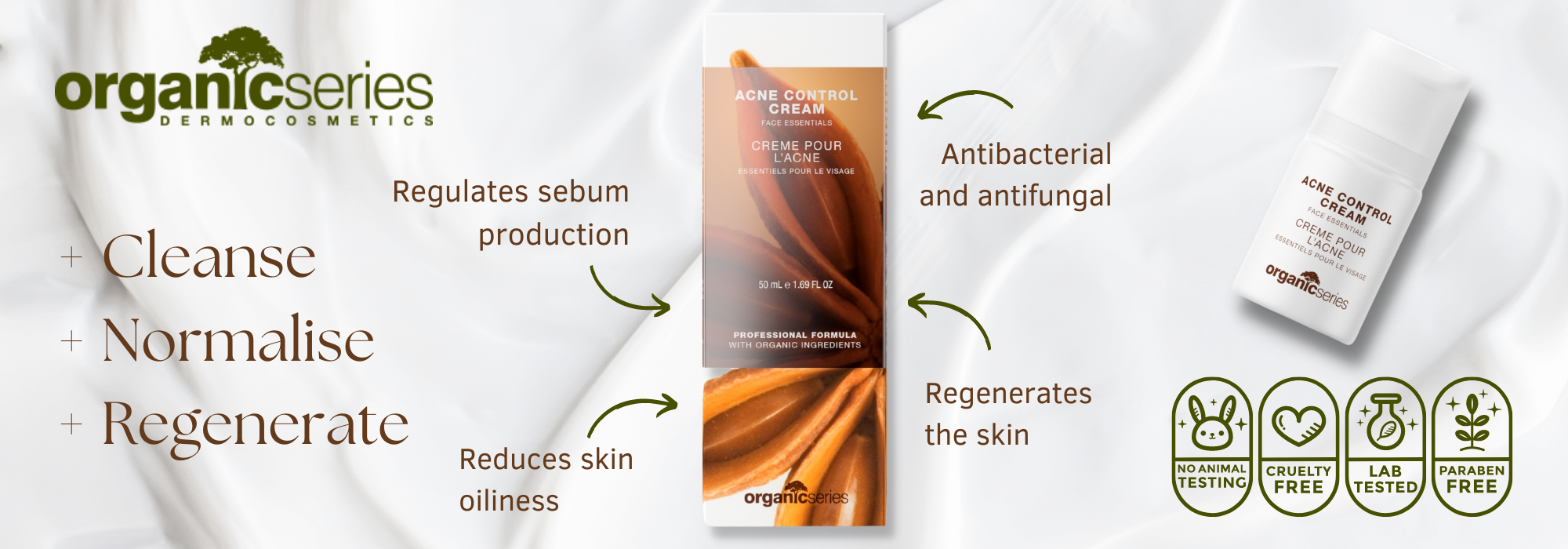
Our Organic Acne Cream contains shikimic acid which directly affects the composition of sebum and has an antibacterial and antifungal effect. It will effectively inhibit the development of Propionibacterium Acnes, the bacteria responsible for acne changes. It will regenerate the skin from photodamages and discolorations, leaving it luminously smooth. Azeloglycine will significantly reduce oily skin and regulate the sebaceous glands. It will reduce TEWL (transepidermal water loss) and give the skin excellent moisture and remain silky smooth. Our Organic Acne Cream has just the ideal amount of oils and will never weigh your skin down not cause any unwanted oiliness. Face cream for acne.
Benefits
Antibacterial and antifungal.
Inhibits microbial growth.
Regenerates the skin.
Leaves the skin silky smooth.
Reduces skin oiliness.
Regulates sebum production.
Moisturises and smoothens the skin.
How to use
Wash your skin, you can use our Optimal Cleansing Cleanser. Apply a thin layer of Organic Acne Cream and gently massage it into the skin until fully absorbed. The cream can be used as a finishing touch to the Organic Acne treatment. Face cream for acne!
Active ingredients
Azeoglycine – has an antibacterial effect, inhibits the thyroxine enzyme. Regulates sebaceous glands, normalises sebum secretion and strongly moisturises.
Shakikian Acid – has an exfoliating, antibacterial and antifungal effect. Unblocks plugged sebaceous gland outlets, inhibits the development of Propionibacterium Acnes.
Green Tea Extract – has antibacterial, antiviral, anti-inflammatory and anti-aging properties. Reduces the formation of erythema, relieves inflammation, tones and eliminates the burning sensation.
Chia Seed Oil – makes skin flexible, strongly moisturises by reducing transepidermal water loss. Has antioxidant, anti-inflammatory and protective properties.
Powdered oat – soothes, brings immediate relief to irritated and reddened skin.
Bisabolol – soothes, has an anti-inflammatory and antibacterial effect. Accelerates the healing process, inhibits excessive growth of the epidermis and sebaceous glands. Reduces the effect of pro-inflammatory cytokines.
Lavender oil – strongly disinfects, has antiseptic, anti-inflammatory, antifungal, anti-acne properties. Regulates sebum production, prevents scarring, stimulates new cell growth.
Ingredients
Aqua, Isononyl Isononanoate, Potassium Azeloyl Diglycinate, Avena Sativa (Oat) Kernel Flour, Cetearyl Alcohol, Salvia Hispanica (Chia) Seed Oil, Perilla Ocymoides Seed Oil, Isostearyl Isostearate, Glycerin, Trahalose, Glyceryl Stearate, Epilobium Angustifolium Flower / Leaf / Stem Extract, Shiconic Acid, Stearic Acid, Cetearyl Glucoside, Sodium PCA, Camellia Sinensis Leaf Extract, Tocopherol, Helianthus Annuus (Sunflower) Seed Oil, Bisabolol, Lavendula Angustinfolia Oil, Benzyl Alcohol, Dehydroacetic Acid, Tetrasodium Glutamate Diacetate. ** emulsifiers, preservatives and detergents are of organic origin or approved for use by Ecocert.
Hazards and Cautions
Store in a dry, dark and cool place. Keep out of reach of children.
Face Cream for Acne By Organic Series
-
Face Moisturiser with Sunscreen SPF40 | Moisturising Cream SPF High Protection By Organic Series | 15ml, 50ml
From £ 12.00Rated 4.67 out of 506 reviews -
-
Organic Acne Cream | Acne Control Cream By Organic Series | 15ml, 50ml, 200ml
From £ 12.00Rated 4.75 out of 504 reviews -
Organic Acne Serum | Acne Control Serum By Organic Series | 15ml, 50ml, 200ml
From £ 12.00Rated 4.75 out of 504 reviews -
Organic Facial Cleanser | Optimal Facial Cleanser By Organic Series | 50ml, 200ml
From £ 24.00Rated 5.00 out of 505 reviews -
Organic Vitamin C Serum 10% | By Organic Series | 15 ml, 50 ml, 200 ml
From £ 12.00Rated 5.00 out of 505 reviews

Maria
Cosmetic Chemist
Maria
All Author Posts


